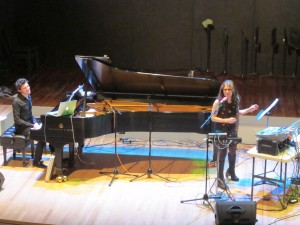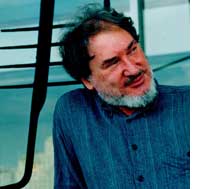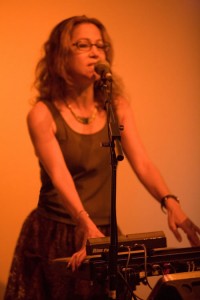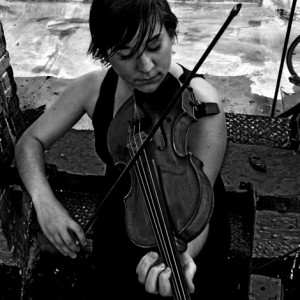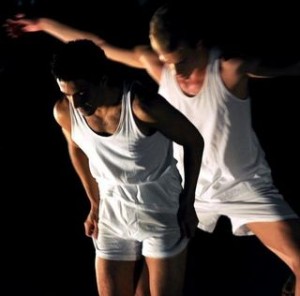 For a few different takes on reality, you ought to go check out FIVE POINTS, a collaboration between PULSE Composers Collective and TAKE dance: “a true marriage of contemporary dance and music inspired by the senses and synesthesia.”
For a few different takes on reality, you ought to go check out FIVE POINTS, a collaboration between PULSE Composers Collective and TAKE dance: “a true marriage of contemporary dance and music inspired by the senses and synesthesia.”
Five composers, five pieces, five dances!
Joseph C. Phillips Jr. founded the composer federation Pulse in 2004 with composers who shared a desire to create and perform music that has no rigid divisions or categories, and I was lucky enough to ask him a few questions about FIVE POINTS, the second collaboration between these two groups:
1) When you write for a choreographer, do you have dancers and movement in mind, or are you just leaving it up to the dancers to work with the sound world you create?
Since much of my music is quite rhythmic, movement is often directly linked to it, whether for dance or not. Some of my best pieces begin with me dancing or moving as I am composing it and I often imagine people groovin’ to something I have written. When writing specifically for dance, I do imagine what types of motion or movement might be appropriate for the music, but don’t usually suggest this to the choreographer. I have worked with three different dance companies and four choreographers over the years and each experience is a bit different but I am always surprised, however, when I see the actual choreography and how differently the movement is to what I thought it might be, but also how well it works with the music.
2) Along that line, how much involvement did you have with the Kile Hotchkiss? Did you know that the dance would be for six female dancers and did the choreographer have any particular requests for you?
For last year’s project, Take and I randomly picked composers and choreographers to work together. This year we just assigned people, so I knew what Kile was capable of from last year’s wonderful piece with Darcy James Argue. I wanted to have a contrast with my composition from last year, which was a slower, more contemplative work with Take choreographing, but also something a little different musically from what Kile worked with last year. So starting this summer Kile and I mostly emailed back and forth, I told him my broaden thoughts on synesthesia (actualized sound through movement, as representative from the disco era) and he shared his (Cymatics, the visual representation of sound either in wave patterns or material substances). We talked a little about how the piece would “feel” and from there it was straight-forward: I would send sound file sketches, he would offer feedback on how the choreography might work with music, I would keep going or make changes (sometimes I would resist certain changes on musical grounds, in which we would compromise a solution). In the process, Kile mention the dance was all-female (which was helpful to know and visualize as I was creating) and did have a few specific request about certain sections of the music (a little too “cheery” here, maybe more “fierce” there, can the ending be extended slightly), but overall the process was smooth and very collaborative.
3) After the music and choreography were finished, was there much dialog and revision based on the visions of composer v. choreographer?
Since we were communicating throughout the composing/early choreographing phases, any revisions and editing happened before the piece was fully finished so it already matched our conception once completed.
4) The whole program has a “synesthesia” theme: Do you have synesthesia, and if so, what kind?
No, I am not officially a synesthete. Although like many people, I have experienced aspects of synesthesia.
5) And-your piece, “The Substance of Things Unseen,” is said to create “adventitious synesthesia.” Can you speak a little bit about what this is and how the music and dance work together to create this experience?
Adventitious synesthesia is when the heighten perceptional experiences are artificially induced rather than produced by genetic causes. My composition, which is actually titled “Unlimited” (the dance is “The Substance of Things Unseen”), was inspired by both my thoughts and feelings about a particular passage on disco in the 1995 PBS/BBC documentary “Rock and Roll” and Kile’s research into cymatics. The movement Kile created for “The Substance of Things Unseen” is very dynamic and exciting and while he does not take my disco concept literally, the joy in motion and movement of one’s body, which I associate with the disco era, is certainly present. The music is constantly driving and pushing and Kile creates movement that is just as forceful and energetic. I thought about dance as visualized sound and how for dancers particular sounds might mean particular gestures (how one’s “head and neck do things it didn’t know it could do” based on hearing a groove or rhythm) or how being on the dance floor might induce a specific heighten feeling, and I wanted to create music that reflected those thoughts.
6) How do you feel all the pieces interact together? Is there one cohesive narrative through the evening or will the audience experience vignettes?
While there is no overall narrative in FIVE POINTS, there is a good sense of balance in the program, with all of the pieces bringing together different perspectives on synesthesia; there are large ensemble pieces, a quirky and humorous one, and quieter emotive pieces. Each piece is a world unto itself like a collection of short stories on a overriding subject, with the composers and choreographers creating some fascinating images and sounds. Pulse and TAKE Dance work quite well together (and as a composer it is so stimulating to see your music danced to) and hopefully there will be a TAKE DANCE + Pulse: Part 3!
For TAKE DANCE + Pulse Part 2, head on over to Merce Cunningham Dance Studios, 55 Bethune Street
DEC 15-16 @ 9:00PM, DEC 17th @ 8:00PM
